This article first appeared in NMA magazine Issue 7, 1989, Editors Rainer Linz & Richard Vella. In it, the author discusses the formation of The Clifton Hill Community Music Centre (CHCMC) in Melbourne, and gives a chronological outline of activities there.
In
mid-1975 composer Ron Nagorcka returned to Australia
from a sojourn in San Diego,
California. With him came American
Warren Burt, to take up a teaching position with the Music Department of
Latrobe University. Both had been involved in the running of the Atomic Cafe,
the University of California at San
Diego's alternative performance series. Nagorcka had
also witnessed the bitter infighting and factionalism that had plagued the Melbourne branch of the International Society for Contemporary Music (ISCM) and the New Music Centre in
the early 1970s. From these experiences he formulated the principles that would
govern the Clifton Hill Community Music Centre (CHCMC) over its eight-year lifespan.
They were such that:
1. No money was charged from the audience, thereby eliminating
the notion of possibly not getting one's money's worth (This did alter
slightly - see 1981 section). No money was paid to composers or
performers. No equipment was supplied, and advertising was mostly word of
mouth or very inexpensively photocopied posters. The removal of economics
from the musical equation was of supreme importance in setting up a space
with a truly alternative set of values.
2. Access to the space was completely open and no
restrictions were placed on style or content of performances. All one had
to do was phone the coordinator of the Centre and a date for an event
would be arranged.
3. The Centre was run anarchically. A person elected, or was elected, to be coordinator who was then responsible for allocating performance times, opening and closing the building and allocating the minimal publicity jobs. When that person tired of the coordinator's job, it was passed on to another. In this way, a sense of continuity and adapting to changing needs was built into the Centre's operation.
These principles were tested with concert series at La Mama Theatre and then at the Students' Church, both in Carlton, from August to December 1975. At the
beginning of 1976, space became available at the Organ Factory, a community
centre in Clifton Hill housing the New Theatre group, after-school play groups
and other civic action organisations. The first concert series by the Clifton
Hill Community Music Centre at the Organ Factory was held shortly after with
Nagorcka as coordinator.
Warren Burt took over as coordinator from June 1976 to December 1977 and documentation of events at the Centre during the period from May to December 1977 can be found in the three slim issues of the New Music newspaper, edited by Warren Burt and Les Gilbert to call attention to "the enormous amount of new music in Melbourne". Their first editorial also mentions the attitudes of the mass media to "the broad mass of fine, strong work being done in isolation" as being condescending, non-comprehending or completely ignoring it.
In
early 1977 John Campbell founded the New & Experimental Music Show
(originally titled Amputations) on Community Radio 3CR. This helped to
publicise CHCMC. Campbell, Burt, David Chesworth and John Crawford all
presented programs. In later years most of the CHCMC concerts were taped on
cassette and then played on the program, providing broader exposure for the
Centre and the performers and more than satisfying the station's 50% Australian
content requirement. Eventually, the program moved to 3RRRFM.
David Chesworth took over as coordinator in January 1978 and in the same year coordinated four concert series with a total of 29 concerts. By that stage there were four areas for performance in the double storey factory. Downstairs was a large open space interspersed by pillars over a wood floor. This area was used later for large-scale works, particularly by Graeme Davis, Ernie Althoff, although Randelli (Robert Randall and Frank Bendinelli) used it for video installations in 1978. Upstairs was a small room where most of the early concerts were held, and a small but well-equipped theatre with stage, lights and sloped seating. Next to the theatre was a carpeted foyer area. This foyer area was the only place equipped with a heater. In winter the rest of the building, like all good experimental music centres the world over was cold. Extra chairs and tables resided in various sections of the building. There was also a piano, two big hi-fi speaker boxes with cables, a hot-water urn and mugs, and adequate electric power points.
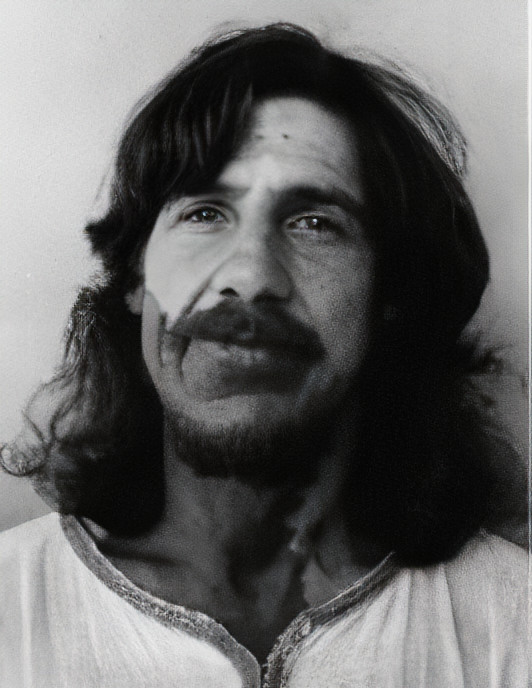
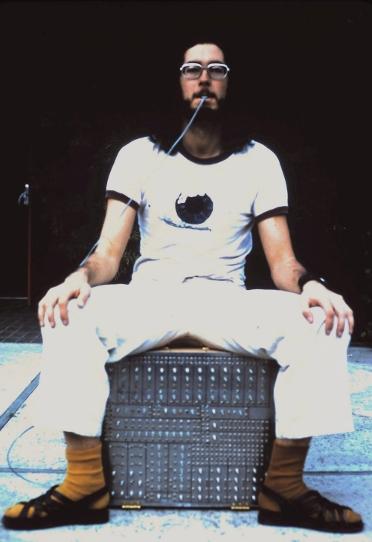

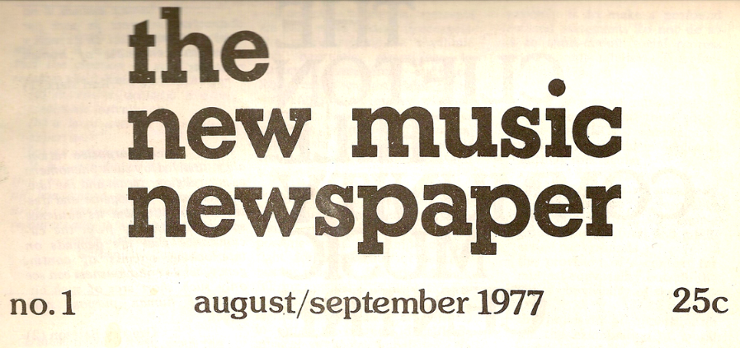
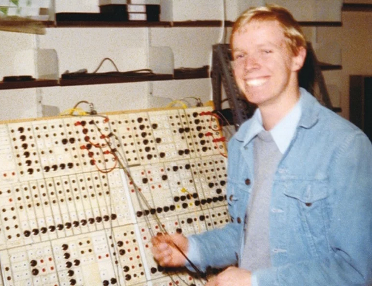
New Music:
In 1980 David Chesworth (Essendon Airport) and Philip Brophy (Tsk Tsk Tsk) created the New Music magazine. Running for a total of six issues, a process of concert review by volunteers, and subsequent interview between reviewer and performer/s filled the pages of four of these magazines with various writing styles, levels of articulation and typewriter fonts. Unfortunately, it was in one instance also the vehicle for an article containing the worst abuse of the freedom implied by the second of the Centre's original principles, and by the editorial statement in each issue.
This led to the first organised meeting the Centre ever staged in December 1980 to discuss the differences of opinion which had arisen. Innocent Records, an independent Australian label, was also established by Chesworth and Brophy. The label was set up to release music by their projects, Tsk Tsk Tsk (→ ↑ →) and Essendon Airport and solo work by Chesworth and others. It also released two compilations of 'new music' from the Clifton Hill Community Music Centre (1978–1979 and 1980). Many releases had screen printed covers created by Brophy and Maria Kozic (also in → ↑ →) and most were produced by Chesworth and John Campbell.



Tracks from the new music compilation, 1980 - Source: Innocent Records
Warren Burt - Reloopse.mp3
L.I.M.E. - O Rose.mp3
The Centre's second principle meant that there were
probably as many musical styles as ensembles and performers, but the 'no
finance' principle did push a few things to the fore. The first was a healthy
and inventive participation in the low-budget ethic. This occurred in several
ways. One was the use of cheap and low-calibre instruments, and in people
trustingly borrowing and lending each other equipment. In the earliest Tsk Tsk
Tsk line-ups both the electric pianos had some non-functioning keys, and the
electric guitar was a borrowed K-Mart special (The equipment of many bands
improved in later years and, as people moved into areas demanding better
equipment such as video production and studio electronics, the production
became more sophisticated).
It was well accepted that low-budget equipment helped to 'shape' the music, not devalue it; there was no stigma attached to its use, although some music students claimed they hated the sounds of out-of-tune toy organs. Mention of toys takes us into another: when no 'real' instruments were available, people used toys, found objects and invented home-built devices for music making. The use of the portable cassette recorder as an instrument for real-time electronic composition and performance was pioneered at the Centre, first by Burt and Nagorcka as Plastic Platypus and then by Graeme Davis and Ernie Althoff. Other synth-type devices also appeared. Bands such as Laughing Hands, heavily dependent on electronic amplification and treatment devices, usually had a contact-miked toy guitar with rubber band strings in there somewhere.
The
second important feature was a strong leaning towards works embodying
multi-arts disciplines. This resulted from confidence in the freedom to invent
and explore musical forms without feeling a need to gratify the audience. Even
the most conventional ensembles surprised audiences with music-theatre pieces
every now and then. Tableau, drama, mime and dance were incorporated
inventively into concerts, and much work was done in the Super-8 film and video
fields.
Indeed, the Super-8 film people saw the ethics of CHCMC aptly befitting their medium. Film and/or video concerts, either combined with music or performance or just shown straight, were featured in all the years of the Centre's operation. Colour slides were also used. Installations activated by audience or performers were constructed. If a performer wanted movement in a piece but couldn't find a dancer or actor willing to perform without payment, they worked out their own set of steps and became the dancer. Most people took on these challenges of new roles in a serious, purposeful and consequently successful manner.
Performers
were genuinely interested in the musical directions of other performers
although the 'music student' performers looked upon the radical musical
adventurousness of the non-academic with perhaps just a tinge of envy. People
questioned and commented freely. Performance arrangements and commitments
stayed flexible, and concerts by one-off hybrids made up of members from
various different bands often provided a new and challenging outlet for musical
ideas. The Dave and Phil Duo and Music 4 both had a longer life, Tsk Tsk Tsk
had a large and varied workforce for their many projects, and Ernie Althoff collaborated
with Warren Burt, Chris Mann and Tsk Tsk Tsk for valuable learning experience.
Click HERE to read about the Institute for Dronal Anarchy (IDA)
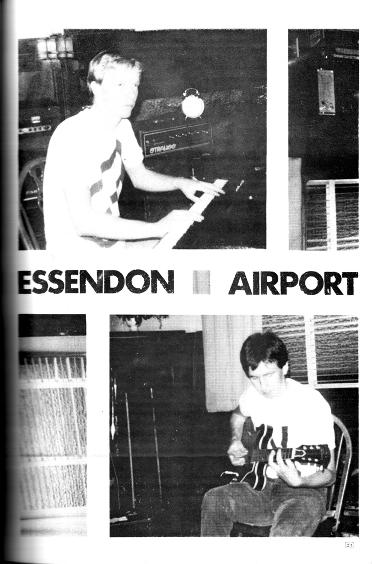

Source: CHCMC Tapes
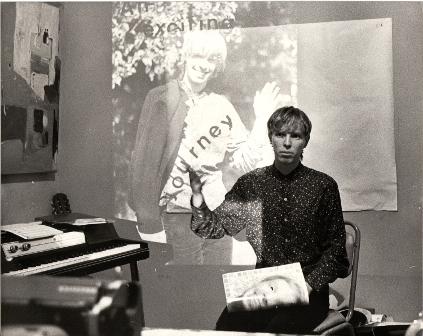
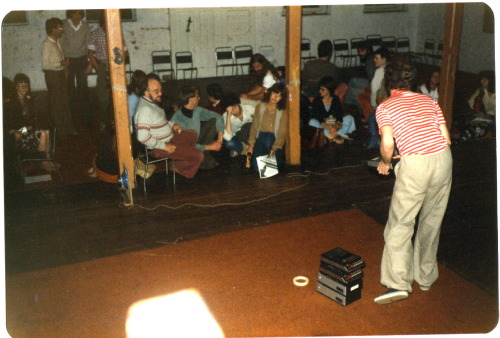
By 1981 a final benefit concert to help pay for the printing of the last issue of the New Music magazine was held at the beginning of the year to a thoroughly packed house. April saw the Centre's second meeting: the building's committee had increased the rent from $100 to over $300 per year. It was decided unanimously to adhere to the original unwritten principles of the Centre, but a voluntary donations jar was positioned in the foyer which worked well. Concerts were free until mid-1982 when a $1 donation was requested, and two benefit concerts were held to pay the rent: one in August 1982 and the other in October 1983.
With
an increase in the exposure of the Centre's participants in other areas,
concert audiences grew more varied and increased in size again. Both Brophy and
Chesworth's bands had attracted a punk/new wave audience from hotel and club
circuits, and more bands started getting work in these venues. Probably the
first major acceptance by the visual arts world of the Centre was through Tsk
Tsk Tsk's July 1980 Asphixiation - what is this thing called
Disco? installation at the George Paton Gallery at Melbourne University.
In 1981 large contingents of CHCMC performers worked in art galleries in Melbourne, regional centres and interstate. This resulted in an influx of visual artists, filmmakers, critics, gallery administrators and arts bureaucrats to the Centre. Some, like the new wave sector, understood and were at ease with the Centre's modus operandi while others, again like the new wave sector, misunderstood the Centre's pluralism and were disappointed and annoyed to enjoy their "favourite new act" one week and to witness something that was often totally incomprehensible to them the next.
Perhaps as a result of the attention from the visual arts world, derivations of French-based arts theory and criticism began to infiltrate some aspects of the activities at CHCMC. A strange manifestation, it attracted much ardent defense and as much equally ardent abuse from the informed and the ignorant on both sides of the fence. Semiotic labels such as `first degree, second degree, third degree...' were bandied about with great passion and great irresponsibility. Strangely inaccurate stories about the Centre's 'militantly rigid ideological thrust' began to filter back to CHCMC from other capitals. It should be emphasized here that none of these events in any way altered the working structure of the Centre.
In August the Centre hosted one of the evening concerts of the 1981 Music and Technology Conference, much to the chagrin of sections of Melbourne's music academia, who otherwise avoided CHCMC totally. Several of the overseas delegates praised the Centre, comparing it favourably with New York's The Kitchen, not only in politics and architecture but also in lack of heating!
In 1982, after four and a half years as coordinator, Chesworth handed the position over to Andrew Preston. Between them they opened the doors to 40 concerts for the year. Statistically this was another successful year for the Centre but, on another level, things had begun to change. Audience sizes diminished and, for the first time since 1976, the coordinator had to ring performers and suggest they do something in order to fill a series. Regulars started forming little one-off bands with each other, sometimes producing innovative results. New people were still appearing: Sue Blakey, Paul Taylor, the tapes of Anti-Music and Sydney musician Louis Burdett were some. In the fourth series, Preston planned four Music Forum events: Brophy, Burt, Adrian Martin and Nagorcka all had an evening each to espouse their musical philosophies, fantasies or foibles and to discuss the ensuing comments, questions and criticisms of the audience. These had mixed results, ranging from voices raised in heated debate to yawning and leaving early, but everything was possible and permissible.
In 1983 to start the year's activities, CHCMC played host to a series of nine afternoon and evening events for the first Melbourne Fringe Arts Festival in February and March. It featured a mixture of regulars and new Fringe performers and filmmakers. From 30 March to 15 June, Preston organized and mostly cajoled material for ten concerts. However, Preston found it harder and harder to fill series and audiences were still dwindling. The altered social and economic climates of the mid-80s, compared to those of the late 70s and even early 80s, led to a marked change in people's responses to experimentation in any artform. This was distinctly noticeable in the increasingly conservative attitudes of tertiary arts faculties and their students.
Disaster struck the Centre in early June when work began on extensive renovations to the building. The last concert was moved to the Living Room in Richmond, and for the next four months the only sounds from the building were those of construction equipment.
During this period, Preston handed the position of co-ordinator over to Robert Goodge, who ran a series of eight concerts in October and November, beginning with a well attended rent-paying benefit concert. The accompanying flier mentioned that the renovations were nearly complete, and that people should put their names on a mailing list for the following year. It also carried the news that the Organ Factory Committee had applied for funding from the Victorian Ministry for the Arts, as well as the standard invitation for performers to present in the usual manner. The last concert for the year was held on 30 November with bands formed by Goodge and Martin, films by Ralph Traviato and Paul Fletcher (Tsk Tsk Tsk and Essendon Airport respectively) and a solo performance by Ernie Althoff.
By 1984 only four people: Robert Goodge, Andrew Preston, Rainer Linz and Ernie Althoff turned up to the Centre's
third meeting on 21 March. Many of the Centre's regular performers were still
overseas as a result of their participation in the 1983 Paris Autumn Festival. Goodge announced
that the application for funding had been successful, but that because of his
present commitments, he should resign as coordinator.
Althoff was offered the position but declined, stating that he saw the present coordinator's job as "begging non-existent performers for non-existent material for non-existent concerts for non-existent audiences", and not really in keeping with the Centre's original principles. He said it would be better to disband the Centre at this stage, which was agreed upon by the others and the grant was returned to the Ministry. It is ironic that the only time the Centre received funding assistance was at the point when it was disbanding for other reasons. Later that week, Althoff told Nagorcka of the decision and Nagorcka answered "Yeah, I think you probably did the right thing!"




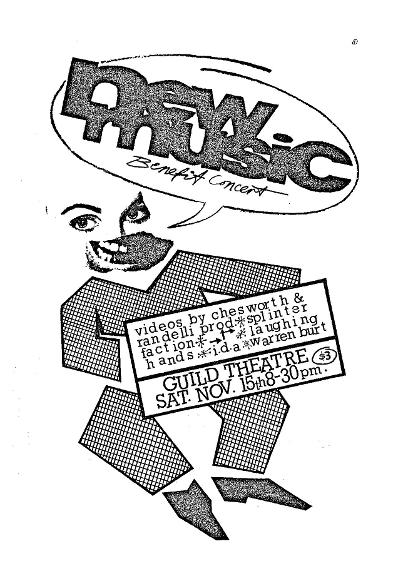
CHCMC Interview.mp3
Interview with David Chesworth, CHCMC, Fast Forward tapes, issue 6, 1981 - Source: Spill Label
Postscript:
Sadly, this was 'the end of an era' for the Centre's regular performers including Essendon Airport, Tsk Tsk Tsk, Ernie Althoff, Rod Nagorcka, Chris Wyatt, Warren Burt, Ros Bandt, John Crawford and Graeme Davis to name a few. As can be seen, Nagorcka's original principles of establishment of the Centre were upheld until the end. In total, 30 posters for concert series from 1978 - 1983 tell it all along with 90 solo performers and ensembles and the 30 or more video and filmmakers who presented at CHCMC in those years.

|
Australian Experimental Music - 1963 - 1990.pdf Size : 878.703 Kb Type : pdf |

|
The '70s in the '90s.pdf Size : 185.763 Kb Type : pdf |
- Main Image - Clifton Hill Community Music Centre, 1976-1984 - Source: David Chesworth
- Background Image - new music poster, 1980, designed by Philip Brophy - Source: David Chesworth
- Ron Nagorcka, c. 1977 - Source: Rainer Linz
- Warren Burt, 1975 - Photo by Roberto Laneri - Source: Warren Burt
- CHCMC, 1976-1984 - Source: CHCMC Tapes
- the new music newspaper, no. 1, 1977 - Source: Warren Burt
- David Chesworth c. 1978 - Source: Last FM
- New Music magazines poster, 1980 - Source: Philip Brophy
- Essendon Airport, 1978 - Source: CHCMC Tapes
- Cassette recorders as compositional tools c.1979 - Source: CHCMC Tapes
- David Chesworth with film, 1979 - Source: David Chesworth
- Ernie Althoff performs at the CHCMC c. 1980 - Source: CHCMC Tapes
- David Chesworth performing with Robert Goodge and Rainer Linz at CHCMC c. 1979 - Source: CHCMC Tapes
- Feminimalism - Tanya McIntyre, Jayne Stevenson, Jules Wiffen, Gayle Slater and Maria Kozic, CHCMC, 1979 - Photo by: Philip Brophy - Source: ACCA
- Ernie Althoff and Graeme Davis of IDA perform four-handed percussive zither in Tautology, 1980 - Source: Rainer Linz
- Tsk Tsk Tsk poster 1980 - Source: David Chesworth
- new music benefit concert poster, 1980 - Source: David Chesworth
- Warren Burt - 'Reloopse' (Burt)
- L.I.M.E - 'O Rose' (Bandt, Doyle, McCarthy, Robb)
- CHCMC interviews - Source: Asia-Pacific and Soundcloud
- Interview with David Chesworth, CHCMC, Fast Forward tapes, issue 6, 1981 - Source: Spill Label
- CHCMC lecture by David Chesworth, 2019 - Source: ACCA
- Burt, W. (1991). Australian Experimental Music 1963-1990. Leonardo Music Journal, 1(1), 5-10. doi:10.2307/1513113
- Dempster, E. Interview with Warren Burt, Writings on Dance No. 18-19, Melbourne, Winter 1999, pp. 51-71.
- http://chcmctapes.tumblr.com/
- https://listeningtothearchive.com/
- http://www.rainerlinz.net/NMA/repr/Clifton_Hill.html
- http://www.rainerlinz.net/NMA/magazine_index.html
- http://www.rainerlinz.net/NMA/22CAC/burt.html
- http://www.rainerlinz.net/NMA/22CAC/althoff.html
- http://www.rainerlinz.net/NMA/articles/IDA.html
- http://www.rainerlinz.net/NMA/22CAC/chesworth.html
- http://shamefilemusic.com/ernie-althoff-cassette-archive/
- http://www.warrenburt.com/new-music-newspaper/
- https://collingwoodhs.org.au/resources/collingwood-history-plaques-project/the-organ-factory/
- https://historyofaussiemusic.blogspot.com/2014/03/ernie-altoff.html
- https://www.discogs.com/artist/363689-David-Chesworth
- http://www.philipbrophy.com/projects/innocent/list.html
- https://philipbrophy.com/projects/nicenoise/info.html
- https://en.wikipedia.org/wiki/Philip_Brophy
- Experimental Music: Audio Explorations in Australia. Edited by Gail Priest